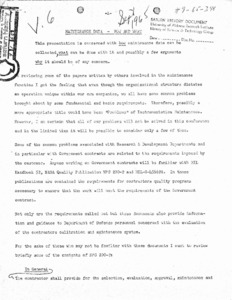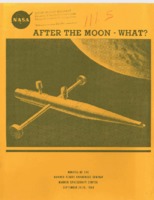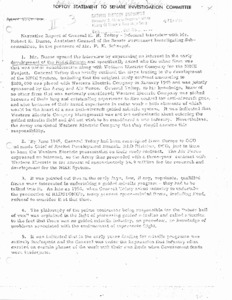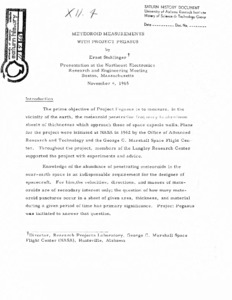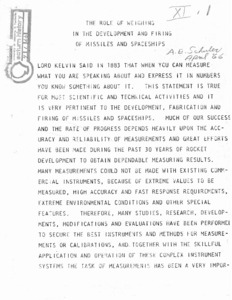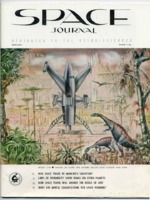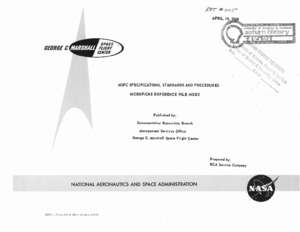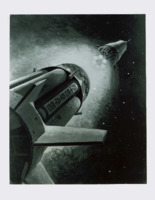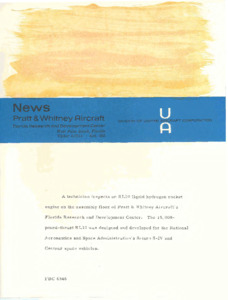
Browse Items (42 total)
Sort by:
-
"Maintenance Data - How and What."
This presentation is concerned with how maintenance data can be collected, what can be done with it and possible a few arguments why it should be of any concern. -
Oral History Interview With Allen Ware
Allen Ware is originally from Atlanta Georgia. He attended Auburn University where he studied Industrial Design . He moved to Huntsville, AL in 1983 to work for a company called "Essex." He worked there from 1983-1991. There, he produced a variety of things. First, he helped produce the Hubble Space Telescope mock-up and crew trainers. Then, he produced some other shuttle mock-ups. After leaving "Essex," he started to work at Boeing in Huntsville where he worked on the International Space Station. There, Ware was an internal and external packager configurator. He did that job for 15 years. He then transitioned to support the Delta IV launch vehicle out of Decatur. There, he did secondary structure design for Delta IV components. Ware is currently an Engineering manager of a Mechanical design team. He has about 15 engineers under him that do spacecraft, aircraft, and launch-vehicle design.Tags Oral History -
"After the Moon - What? Minutes of the Manned Flight Awareness Seminar."
The seminar was held at the Manned Spacecraft Center, September 25-26, 1969. -
"Toftoy statement to Senate Investigation Committee": Development of the Nike system.
Narrative report of general H.N. Toftoy - Informal interview with Mr. Robert E. Dunne, Assistant Counsel of the Senate Permanent Investigating Subcommittee, in the presence of Mr. P. K. Schaeppi. -
"Meteoroid measurements with Project Pegasus."
Presentation at the Northeast Electronics Research and Engineering Meeting, Boston, Massachusetts, November 4, 1965. Ernest Stuhlinger, Director, Research Projects Laboratory, George C. Marshall Space Flight Center (NASA), Huntsville, Alabama.; INTRODUCTION: The prime objective of Project Pegasus is to measure, in the vicinity of the earth, the meteoroid penetration frequency in aluminum sheets of thicknesses which approach those of space capsule walls. Plans for the project were initiated at NASA in 1962 by the Office of Advanced Research and Technology and the George C. Marshall Space Flight Center. Throughout the project, members of the Langley Research Centers supported the project with experiments and advice. -
"The role of weighing in the development and firing of missile and spaceships."
Speech regarding the importance of developing and upgrading space ships and space technology. -
Space Journal, vol. 1, no. 5, March-May 1959.
This issue includes a statement announcing Space Journal's termination of all connections with the U.S. military and with the Rocket City Astronomical Association. At the time, commander of the Army Ballistic Missile Agency (ABMA) at Redstone Arsenal Gen. John B. Medaris was concerned that the publishers and writers, all in the employ of ABMA, were using their government positions for personal gain through the magazine. Topics covered in the issue include the dangers and feasibility of space travel, designing buildings for life on the Moon, and the existence of life elsewhere in the universe. -
"MSFC specifications, standards and procedures microfiche reference file index."
This reference file has been prepared in order to identify data contained on microfiche in the MS-D Repository. This index is divided into three sections. Section I - MSFC Specifications, Section II - MSFC Standards, and Section III - MSFC Procedures. This listing will be kept up-to-date and will be published monthly.; Prepared by: RCA Service Company.; April 15, 1968.; Rpt. #005 (handwritten on the cover). -
Artist's Conception of the RL10-powered Saturn S-IV Stage.
This artist's rendering of the RL10-powered Saturn S-IV stage is depicted as heading toward deep space after separation from the booster. The drawing is accompanied with a brief description of the Saturn S-IV. -
"Technician inspects an RL10 liquid hydrogen engine."
A technician inspects an RLlO liquid hydrogen rocket engine OD the assembly floor. of Pratt & Whitney Aircraft's Florida Research and Development Center. The 115,000-pound-thrust RLlO was designed and developed for the National Aeronautics and Space Administration's Saturn S-IV azld Centaur space vehicles.
